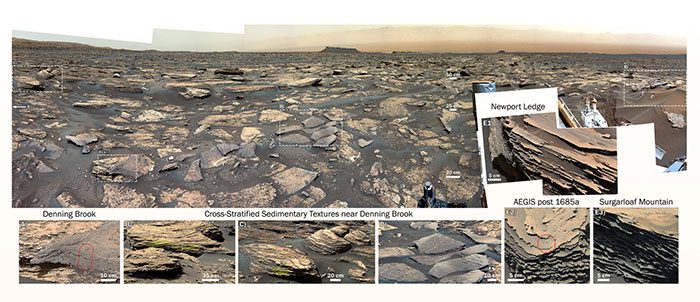At the bottom of an ancient lake on Mars, NASA’s robot has discovered a land strikingly similar to Earth, containing clear hints of life.
A research team led by Dr. Patrick Gasda from the Los Alamos National Laboratory (USA) has unveiled the mystery surrounding an unusual discovery made by Curiosity, NASA’s rover searching for life on Mars.
This discovery, made in May 2017, revealed an unusually high concentration of manganese oxide in the ancient lakebed within Gale Crater, a large impact crater on Mars.
To date, scientists have been puzzled because the known conditions on the red planet do not support the existence of such an environment.

Manganese-rich sedimentary rock discovered at the bottom of a lake on Mars – (Photo: NASA).
In a recently published study in the Journal of Geophysical Research: Planets, the authors discussed how manganese could be enriched in these types of rocks at the lakebed and suggested that life might be the key explanation.
The manganese-rich sedimentary rock explored by the Curiosity rover is a mixture of sand, silt, and clay. This sandy rock is more porous, allowing groundwater to permeate more easily than claystone.
Researchers have considered how manganese could become enriched in this sandstone. For example, through groundwater seeping through sand on the lake shore or river mouth in the delta. At the same time, what oxidizing agents could cause manganese precipitation in the rocks?
On Earth, manganese becomes abundant due to oxygen in the atmosphere, and this process is often accelerated by the presence of bacteria.
Earth bacteria can utilize various oxidation states of manganese as energy for metabolic processes.
“On Mars, we have no evidence of life, and the mechanisms for producing oxygen in Mars’ ancient atmosphere are still unclear. Therefore, how manganese oxide formed and concentrated here truly remains a mystery,” Dr. Gasda stated.
It seems that life is the only reasonable explanation for this puzzling phenomenon.
Thus, the presence of manganese and manganese oxide here may serve as indirect evidence of ancient microorganisms.
If similar life existed on ancient Mars, the increased manganese in the rocks along this lake shore would have been a crucial energy source for their survival and reproduction.
In other words, Gale Crater, where NASA focuses its Curiosity mission, may very well have contained a water body rich in living organisms billions of years ago when Mars was not yet barren.
This is not unreasonable, as Mars lies within the habitable zone of the Solar System, just like Earth.
The evidence NASA has found so far suggests that about 3 billion years ago, this planet had much water like Earth, but unfortunately, it was lost to space.


















































